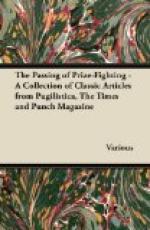“Oo! How wonderful! Do show me how.”
“Very well. Since you are going to be a literary giantess it is well that you should be initiated into the mysteries of producing what I shall call the illusion of spontaneity. Now take this story here. Here on this old envelope is THE IDEA.”
“Oo! Let me see. I can’t read a word.”
“Of course you can’t; nobody could. Rough copies are divided into classes as follows:—
“No. 1. Those I can read, but nobody else can.
“No. 2. Those I can’t read myself after two days.
“No. 3. Those my typist can read.
“This story is about a certain Brigade Major who is an inveterate leg-puller. Some Americans are expected to be coming for instruction. Well, before they arrive the Brigade Major has to go up to the line, and on his way he meets a man with a very new tin hat who asks him in a certain nasal accent we have all come to love if he has seen anything of a party of Americans. Spotting him as a new chum, the Brigade Major offers to show him round the line, and proceeds to pull his leg and tells him the most preposterous nonsense. For instance, on a shot being fired miles away he pretends they are in frightful danger, and leads him bent double round and round trenches in the same circle.”
“What a shame!”
“Wasn’t it? Well, when he gets tired he asks the American if he thinks he has learnt anything. The American says, ’Gee, I’ve been out here two years now, but I guess you’ve taught me a whole heap I didn’t know. I’m a Canadian tunneller, you know, and I’ve got to show some Americans our work, but I guess I’ve had a most interesting time with you.”
“Ha! ha!”
“Well now, to put the story into its form. Here’s Copy No. 1, on this old envelope. ’Americans coming—Brigade Major sees American looking for party—pulls his leg—pretends to being in frightful danger—American is Canadian who has been out two years.’ See? Copy No. 2. Here we begin to till in. Describe Brigade headquarters and previous leg-pulls of Brigade Major. Make up details of what he tells the American—’That’s a trench. That thing you fell over is a coil of wire. This is a sunken road—we sunk it, etc., etc.’ Copy No. 3, additions and details, little touches of local colour, revision of choice of words, heart-rending erasions. And here, my child,” I concluded, bringing out the beautiful, clean, smooth typed copy—“here is the finished work itself, light, pleasant, fluent, humorous and, most important of all, spontaneous.”
“Oo! But how awfully cold-blooded. I thought you smiled to yourself all the time you wrote it.”
“My dear girl, it takes hours. If I smiled continually all that length of time the top of my head would come off.”
“Isn’t it wonderful? Fancy building it all up from jottings on an old envelope! What’s that piece of paper you took out of the typed copy?”




